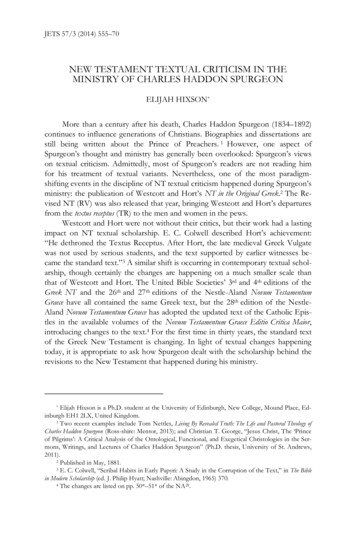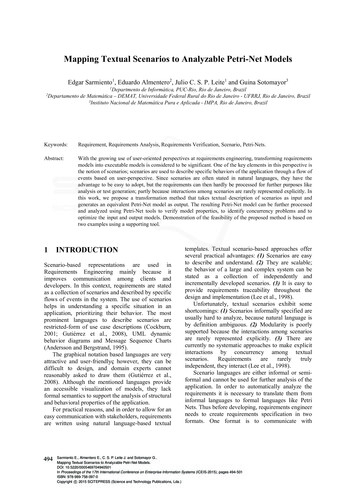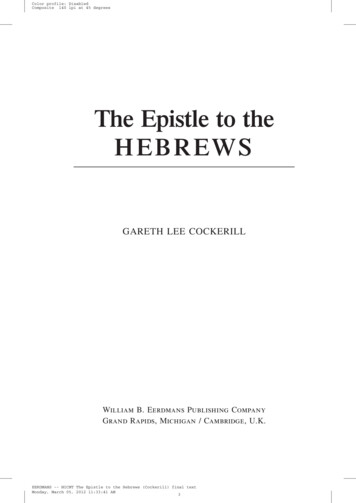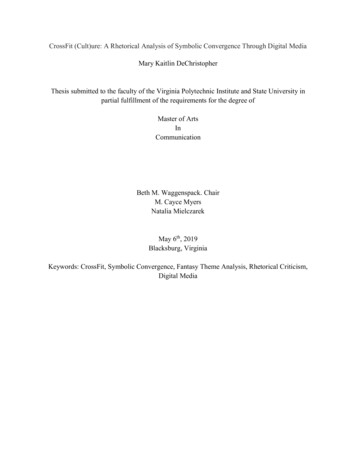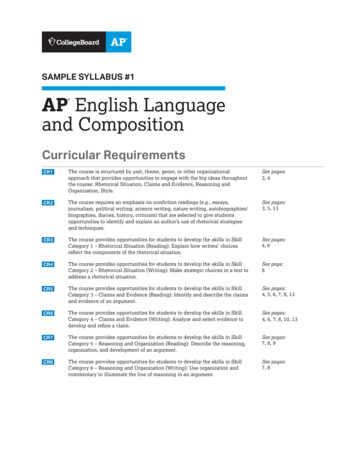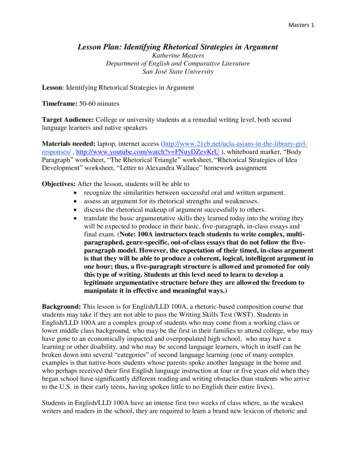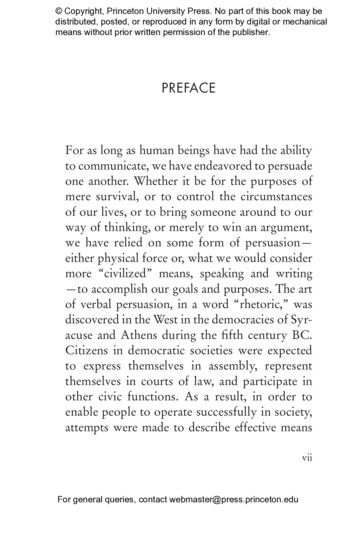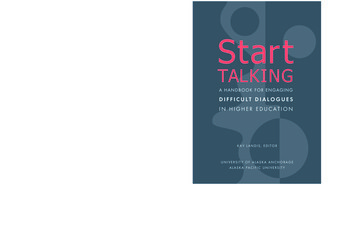
Transcription
Mohammed N. Al-Ali and Yara B. SahawnehRhetorical and Textual Organization of English and ArabicPhD Dissertation Abstracts in LinguisticsAbstractThis study compares English and Arabic PhD dissertation abstracts in the field oflinguistics in an attempt to study the rhetorical and linguistic variations between theabstracts written in English and those written in Arabic. To this end, we have analyzedthe rhetorical components that constitute the macrostructure of fifty English PhDdissertation abstracts written by English native speakers and those underlying fiftyArabic PhD dissertations written by native Arabic speakers following Swales‘ (1990)CARS model of RA introductions and Bhatia‘s (1993) IMRD move structure. Theresults showed differences between the two sets of data in generic structure preferencesin terms of the type and frequency of moves and the linguistic realizations of thesemoves. The rhetorical variations across the two languages are most likely due to sociocultural and academic expectations. The differences related to certain linguisticrealizations such as voice and tense choice are ascribed either to inherent linguisticdifferences between the two languages or to academic practice. The study highlights theimportance of teaching abstracts writing skills to PhD candidates.1. Abstract genre as an academic practiceThe abstract that accompanies research articles and dissertations is anotable practice in academic research as it constitutes a gateway to thereading or publication of a research article or a thesis (Lores 2004: 281).Salager-Mayer (1992) perceives this genre as a distinctive category ofdiscourse intended to communicate factual new knowledge for members ofdifferent academic communities. The abstracts play a pivotal role inprofessional reading as they help readers decide on the relevance of anarticle to their interests (Busa 2005) and give researchers an adequate viewof whether a particular longer text is worth reading. Similarly, MartinMartin (2003, 2005) notes that abstracts function as a time saving device byinforming the readers about the content of the article, indicating whetherthe full text merits further attention.SKY Journal of Linguistics 24 (2011), 7–39
8MOHAMMED N. AL-ALI AND YARA B. SAHAWNEHPhD dissertation abstract writing is an academic practice that allcandidates from different fields have to adopt when they write a full PhDthesis while doing their postgraduate course or research. In most caseswriting a PhD dissertation is only attempted once in a graduate student‘scareer. The great majority of dissertations are prefaced by an informativeabstract, which contains a ―factual summary of the much longer report, andis meant to give the reader an exact and concise knowledge of the full[dissertation]‖ (Bhatia 1993: 78).The dissertation and research article abstract, as a genre, is arecognizable situated linguistic behavior in an institutionalized academicsetting, having a set of communicative functions mutually-understood byestablished members of the academic community. Irrespective of thesubject they serve, abstracts function as being ―advance indicators of thecontent and structure of the following text‖ (Swales 1990: 179). Theabstract is meant to function as a representation as in Bazerman (1984: 58),front matters as in Swales (1990: 179), as a summary as in Bhatia (1993:78) and Kaplan et al. (1994: 405).Though each dissertation is prefaced by an abstract and both areprepared by the same author, meant for the same readership and share thesame contextual configuration, the abstract is thought of as a distinct andindependent discourse genre of an associated text (i.e. dissertation orresearch article). Each genre has a well-defined communicative purposearticulated by its overall rhetorical organization. As stated by Van Dijk(1980), the abstract can be viewed as an integral piece of discourse; it canappear in abstracting journals and in on-line retrieval systems whichpublish paper abstracts. Its appearance in abstracting journals is designed tolead the readers back to the original text (Swales 1990). Given this merit,information scientists have been interested in the standards that wouldincrease the quality and retrievability of abstracts (Chan & Foo 2004) andthat would assess the content of a publication and facilitate the retrievalprocess (Lin et al. 2006). For Ventola (1994: 333), abstracts ―have becomea tool of mastering and managing the ever increasing information flow inthe scientific community‖ as they are the first part of the dissertation or theresearch article to be read.
ENGLISH AND ARABIC PHD DISSERTATION ABSTRACTS IN LINGUISTICS92. The features of abstracts in previous literaturePrevious studies have mainly focused on investigating the rhetorical andlinguistic features of research article abstracts attempting to identify anddescribe the relation between the different moves that constitute this genreand the linguistic features that indicate each of its component moves. Someof these studies focused on research article abstract in specific disciplines,other studies shed light on variations across disciplines and cultures, andothers examined the possible impact of language choice in abstracts. Forinstance, Salager-Meyer (1990, 1992), Busch-Lauer (1995), Anderson &Maclean (1997) and Lin et al. (2006) focused on the rhetorical structure ofmedical English abstracts; Huckin (2001) on biomedicine; Gibson (1993)explored certain linguistic variables that affect the success of abstract in thefield of information and library science; Santos (1996), Hyland (2000),Dahl (2004) and Lores (2004) investigated the textual and rhetorical movesalong with some of the linguistic features that express abstracts inlinguistics, and Pho (2008) considered the rhetorical moves and theauthorial stance in the fields of applied linguistics and educationaltechnology.Variation of abstracts across disciplines has been studied by differentresearchers (e.g. Melander et al. 1997, Hyland 2000, Huckin 2001, Samarj2002, Stotesbury 2003, Dahl 2004, Bondi, 2005, and Busa 2005). Forexample, Melander et al. (1997) examined the possible impact of languagechoice in abstracts from three different disciplines and find that linguisticsand biology abstracts produced in ―the American context are different intheir overall organization‖. Huckin (2001) found that biomedical researcharticle abstracts often do not include the purpose move. Along the samelines, Samraj (2002) showed that the centrality claim moves are morecrucial in the abstracts of Conservation Biology than those in WildlifeBehavior. Stotesbury (2003) demonstrated that evaluation attributes weretwice as common in the humanities and social science abstracts as in thosefrom the natural sciences. Bondi (2005) found that scientific procedures areforegrounded in economics abstracts. This tendency was also confirmed byBusa (2005), who confirmed a preference for the thematization of discourseproducts and procedures in economics abstracts. In contrast, psychologyabstracts, as reported by Busa, reflected a preference for the foregroundingof the discourse objects over discourse products and procedures.
10MOHAMMED N. AL-ALI AND YARA B. SAHAWNEHMartin-Martin (2005) pointed out that the choice of certain rhetoricaloptions to convey knowledge claims vary across a number of dimensions,including languages and cultures. Regarding language, there has been anumber of contrastive or comparative studies that have investigatedvariations in rhetorical strategies of written abstracts in English and thosein other languages (e.g. Melander et al. 1997; Martin-Martin 2003; MartinMartin & Burgess 2004; Bonn & Swales (2007). In an attempt to find theimpact of language choice in abstracts from three different disciplines inthe United States and Sweden, Melander et al. (1997) reported thatlinguistics abstracts showed strong national and cultural differences, andbiology abstracts produced in ―the American context are different in theiroverall organization‖. Martin-Martin (2003) investigated the rhetoricalvariation between the research article abstracts written in English and thosewritten in Spanish in the field of experimental social sciences. The resultsrevealed a strong tendency on the part of Spanish writers to exclude theResults section as opposed to the high frequency of this unit (86%) in theabstracts written in English. Likewise, Establishing a niche was selected in42% of English abstracts whereas it is considerably lower (15%) in Spanishabstracts. The researcher relates the latter differences to socio-culturalfactors such as the relationship between the writer and the academiccommunity he addresses. In a subsequent study in the field of experimentalsocial sciences, Martin-Martin (2005) offered an account of how therhetorical practices including hedging devices, the use of first pronouns andthe expressions of criticism that academics in English and Spanish use inthe area of phonetics and psychology are a reflection of the social relationsbetween writers and readers within different discourse communities anddifferent cultures.In a comparison between Spanish and English abstracts, MartinMartin and Burgess (2004) found that English abstracts showed morecriticism than their Spanish counterparts. In particular, English abstractstended to make more use of impersonal and indirect ways of criticizingthan their Spanish counterparts. In their analysis of English and Frenchabstracts selected from English and French monolingual journals, Bonn andSwales (2007) found that French abstracts displayed less instances of use offirst person singular pronouns; instead, they preferred using first personplural pronouns even though all the abstracts were single-authored,
ENGLISH AND ARABIC PHD DISSERTATION ABSTRACTS IN LINGUISTICS11whereas in the English abstracts, the choice was determined by the numberof authors.All of the studies of abstracts considered so far have focused on whathas been written in English and other languages, apart from Arabic. Except,perhaps, for books compiling PhD dissertation abstracts in Arabic (e.g. Ali1979) and another about abstracting as a genre in Arabic (Abdel Hadi andZayed 2000), no published studies, as far as we know, appear to havespecifically analyzed PhD abstracts written in Arabic in terms of theirsequential component organizational patterns and the lexico-grammaticalexponents used to express these patterns. Abdel Hadi and Zayed (2000)proposed schematic patterns as pedagogic tools that may present potentialadvantages for novice writers by giving them a picture about the differenttypes of abstracts and their components, and how to prepare abstracts interms of style, length and content, as well as how information is typicallyorganized.The literature review has revealed that research article abstracts havebeen the focus of a number of studies. Despite the fact that writing a PhDdissertation accompanied by an abstract is considered a formidable task forany graduate student and as such deserves greater attention, no work ofwhich we are aware has attempted to analyze the rhetorical components ofthe dissertation abstracts in Arabic and English linguistics or has looked forthe linguistic and socio-cultural norms and options that govern theirrhetorical organization. Therefore, this paper is an attempt to examinecomparatively the generic structure and the linguistic options in EnglishPhD dissertation abstracts and those written in Arabic, with the aim offinding out the generic options and linguistic choices that characterize thetwo academic communities (i.e. the writers of English dissertation abstractand Arab writers). A further purpose of this study is to find out to whatextent the linguistic and socio-cultural factors may condition the writers‘rhetorical and linguistic choices.3. The construction of the corpusA total of 100 PhD dissertation abstracts written in English and Arabicwere used in the present study. The corpus in English is made up of fiftyEnglish abstracts written by native speakers of English and submittedduring the period 1984–2009. Seventy percent of the texts were selected
12MOHAMMED N. AL-ALI AND YARA B. SAHAWNEHfrom seventeen American universities, and thirty percent were from sevenBritish universities. This unequal distribution of English corpus (i.e. 70%from US universities and 30% from British ones) would be morerepresentative of the data than taking 50–50% if we take into considerationthe percentage of population of these two countries. It is worth noting thatthe British and American writers of abstracts do not have a completelyhomogeneous culture. However, they are likely to maintain the genericstructure of abstracts irrespective of cultural values in order to operate in amanner acceptable to the members of the academic community who sharecore academic discourses, textual practices and organizational genericpatterns, irrespective of stylistic or linguistic variations, which are beyondthe scope of this study. The English corpus was collected from ProQuestDissertations & Thesis Databases (http://www.proquest.com/enUS/catalogs/databases) and The Linguistlist (http://linguistlist.org/pubs/diss/index.cfm).The corpus in Arabic consists of 50 PhD dissertation abstracts writtenby doctoral Arabic native speakers from Jordanian universities andsubmitted during the period 1994–2009. All the texts collected were inpaper-written format, most of which were collected from the Theses &Dissertation Depository Center in the University of Jordan Library. ThisCenter contains thousands of PhD dissertations from different well-knownuniversities in the Arab world. Surprisingly, we found that not all Arabiclinguistics dissertations deposited in this center included abstracts,especially those deposited from Arab countries other than Jordan. Themajor criterion guiding the selection of Arabic abstracts was ‗accessibility‘of the data. Since the Jordanian PhD candidates in linguistics were the onlyones who were found to include abstracts in their dissertations deposited inthe center, the Arabic sample was selected only from Jordanian publicuniversities that have PhD programs in Arabic linguistics, such as YarmoukUniversity, The University of Jordan and Muta University.Considering that the rhetorical structure of linguistic features of onediscipline can be different from those of other disciplines, and in order toavoid variations across disciplinary boundaries (Al-Ali 2010), theresearchers gathered the sample only from texts belonging to the field oflinguistics. According to Gnutzmann & Oldenburg (1991), the degree ofuniformity of textual structures depends on the discipline to which the textsbelong.
ENGLISH AND ARABIC PHD DISSERTATION ABSTRACTS IN LINGUISTICS134. Theoretical framework and procedure of data analysisThe present study is conducted within the framework of genre analysis.According to Miller (1984), genres are developed by communities aroundsets of communicative events. The essence of the notion of genre analysisis to consider a genre text as a recognizable communicative eventcharacterized by a set of a communicative purpose(s) reflected in thecognitive structuring of the genre (Swales 1990; Bhatia 1993).The data analysis of this study drew mainly on Bhatia‘s (1993) fourmove model (i.e. introducing purpose, describing methodology,summarizing results and presenting conclusions) mirroring the structure ofthe research article (RA) and Swales‘ CARS (Creating a Research Space)model for research article introductions, which consists of the followingthree moves, each made up of different constituent steps:Move 1 Establishing a territory: claiming centrality, making topic generalization,reviewing items of previous literature.Move 2 Creating a niche: counter-claiming, indicating a gap, question raising,continuing a tradition.Move 3 Occupying the niche: outlining purpose or announcing present research,announcing principle findings, indicating RA structure.However, the researchers found that Swales‘ and Bhatia‘s models didnot accommodate all the component moves found in the data analyzed.That is to say, the Arabic and English texts analyzed were found to includesome component moves that have not been identified in Swales‘ andBhatia‘s data. Therefore, the researchers found it necessary to modify someof these moves and add other new components to the model of analysis.For example, the researchers added the ‗Promoting thesis‘ move to achievea strategic function specific to the Arabic abstracts and the ‗Introducingbenefits‘. Furthermore, we modified Step 4 of Swales model, which cameto be termed ‗Indicating thesis structure and content‘. Likewise, wemodified Bhatia‘s ‗Describing methodology‘ and ‗Presenting conclusions‘,which came to be termed ‗Describing methodology and analysisprocedures‘ and ‗Presenting conclusions and recommendations‘,respectively.The rhetorical structure of abstracts of the current study was analyzedin terms of the component moves that make up each individual text. The
14MOHAMMED N. AL-ALI AND YARA B. SAHAWNEHterm ‗move‘, as used by Swales (1981, 1990), varies in length but at leastcontains one proposition that may be conveyed by one sentence or moreand sometimes by a clause or a phrase, as noted by Bhatia (1993), Holmes(1997) and Al-Ali (1999, 2004). Therefore, it is difficult to identify moveboundaries on formal linguistic criteria only. Consequently, assigning afunction for a particular move is mainly guided by both implicit knowledge(Sandig 1986, quoted in Szurawitzki 2008) of generic conventions andexplicit lexical items and phrases signaling information contained in eachtext portion (i.e. move) (Al-Ali 2009). Implicit knowledge, according toSandig (1986: 132), might be brought about by drawing on the textualconventions of a particular genre, establishing relations of different textualelements and the theme and understanding how textual elements are relatedin a greater linguistic context. When we turned to the examination of theconstituent moves of this genre, we drew on our background knowledge ofthe generic rhetorical organizational conventions, inference from contentand knowledge of the context. That is because, according to Bhatia (2004),the schematic generic patterns of a text are the result of the conventions ofthe socio-cultural contexts in which genres are written. However, we notedthat most of the moves have been signaled explicitly in indicative lexicalphrasal expressions. For example, lexical signals like ‗the aim or purposeof the study‘ indicate occupying the niche move, whereas ‗the methodsused to collect data‘ signals describing methodology move. Likewise,lexical items such as find, reveal, indicate, et ct. suggest summarizingresults move, or presenting conclusions. Since move analysis involves adegree of subjectivity that is perhaps unavoidable (Holmes 1997: 325),another trained linguist was asked to identify the component moves of fiftyabstracts selected randomly from the sample. Then the researchersthemselves and the other linguist set together to check the degree ofconformity in their analysis. There were slight differences found, but aconsensus was reached after discussing the differences. The researcherscompared and contrasted the Arabic corpus with the English corpus inorder to find the similarities and differences between the two groups interms of the type, frequency, number and language used to express thecomponent moves employed by the writers.
ENGLISH AND ARABIC PHD DISSERTATION ABSTRACTS IN LINGUISTICS155. Results of data analysis5.1 Component Moves of English and Arabic PhD dissertationabstractsThe results of the generic structure of dissertation abstracts revealed thecomponent strategic moves that tend to occur in the corpus texts analyzed(see Table 1). Each component will be defined, illustrated and exemplifiedby instances from the corpus. For purposes of illustration, examples oflinguistic exponents and signals are often italicized or underlined.Table 1. Component Moves of English and Arabic PhD dissertation abstractsComponent moves ofEnglish abstractsFrequencyof moves(%)1. Claiming centrality2. Making a topic generalization6243. Referring to previous research204. Indicating a gapComponent moves ofArabic abstractsFrequencyof moves(%)1. Claiming centrality2. Making a topicgeneralization1230164. Indicating a gap125. Announcing presentresearch or Outlining purpose6. Indicating thesis structure andcontent7. Describing methods andAnalysis Procedures8. Summarizing results968610. Introducing benefits11.Presenting conclusionsand recommendations26465. Announcing presentresearch or Outlining purpose6. Indicating thesis structureand content7. Describing methods andAnalysis Procedures8. Summarizing results9. Promoting thesis10. Introducing benefits11. Presenting conclusionsand recommendations287082784240161065.1.1 Claiming centralityAuthors, in this move, appeal to the peer members of the academicdiscourse community that ―the research about to be presented is part of alively, significant or well-established research area‖ (Swales 1990: 144).The frequency of occurrence of this move in Arabic abstracts (12%) is
16MOHAMMED N. AL-ALI AND YARA B. SAHAWNEHrelatively higher than that in English corpus (6%). Our analysis of thismove indicated that the authors use more than one strategy to claim thecentrality of their work; they utilize ‗claiming importance of the research tobe reported‘ as in examples 1 and 2, and ‗indicating continuing interest‘ asin 3. In the following examples the lexical signals indicating this move areitalicized.(1)Neutralization is a fundamental construct in the history of phonological theory.(EA 11)(2)(AA 38). ظاٌشج انخالف فً انىحُ انؼشتً مه أتشص ما ذىاَل انذسط انىحُي ‗The phenomenon of disagreement in Arabic grammar is one of the prominentissues that have been dealt with in grammar research.‘(3)(AA 31)‗Media is a topic of increasing importance.‘.ً اإلػالمٍح مُضُع ذرىامى أٌمٍر As is shown in the examples above, the writers tend to indicate theimportance of the topic by using the key signal lexical items: fundamentalor ‗ أتشص prominent‘, whereas the continuing interest claims are expressed bythe lexical item ً ‗ ذرىامى أٌمٍر increasing importance‘.5.1.2 Making a topic generalizationThe second option of introduction openers is making ―statements aboutknowledge or practice‖ (Swales 1990:146). This component occurred in30% of Arabic data, whereas it occurred in 24% of the English sample.Typically, the following examples express in general terms the current stateof knowledge or techniques (i.e. tools) as in the case of example 4, or referto phenomena as in instances 5 and 6.Both English and Arab PhD candidates in linguistics used subjectsthat refer to a general topic in the field associated with verbs in the presenttense. In the following examples the lexical signals indicating this move areitalicized and the tenses are underlined.(4)(5)Propositions are one of the tools languages can use to work and distinguish rolesassociated with (EA 23)(AA 30). ذمثم ظاٌشج انحزف انصشفً وُػا مه انرطُس انهغُي
ENGLISH AND ARABIC PHD DISSERTATION ABSTRACTS IN LINGUISTICS17‗The phenomenon of morphological deletion represents a type of languagedevelopment‘(6)(AA 24) ٌؼذ انؼذَل انىحُي فً انسٍاق انمشاوً ظاٌشج اسهُتٍح نغٌُح ‗Grammatical deviation in the Qur‘anic context is considered a stylisticphenomenon ‘5.1.3 Referring to previous researchThe aim of this move is to indicate that the thesis derives from a livelytradition of established works in the field (Nwogu 1997: 126). Thiscomponent move was found in 20% of English abstracts, but it was notpresent in the Arabic texts. The analysis revealed that English PhDcandidates in linguistics either specify the names of other researchers, as inexample 7, or refer to previous studies in general (e.g. recent debates,previous studies ). The verb tense accompanying these subjects is thepresent simple.(7)Bickerton (1981) and others claim that children can become proficient in alanguage even when they are exposed only to non-proficient speakers. (EA 3)5.1.4 Indicating a gapThis move points out that the previous research has some limitations thatneed investigation. The data revealed that this component occurred in 12%of the Arabic data in contrast to 16% in the English sample. Representativeabbreviated examples with the lexical signals italicized and the tenseunderlined are given in examples 8 and 9.(8)Existing research has focused on abstract mental representation of grammar, andlittle is known about (EA 17)(9)(AA 34). ال ودذ دساسح َصفٍح احصائٍح َافٍح نكم مظاٌش تىاء اندمهح ‗We do not find a comprehensive descriptive and statistical study of the differentaspects of sentence structure ‘
18MOHAMMED N. AL-ALI AND YARA B. SAHAWNEHTo express this move, English PhD candidates in linguistics tend to userestricting quantifiers such as little, as in example 8, or other qualifyingexpressions indicating negative meaning, such as short. The Arab PhDcandidates in linguistics, on the other hand, negate the verb phrase bymaking use of negative articles such as ( ال laa) as in 9, or ( لم lamm) both ofwhich mean ‗not‘. We also notice that English and Arab PhD candidates inlinguistics tend to use the simple present tense to express this move.5.1.5 Announcing present research or Outlining purposeAccording to Swales‘ CARS model, after indicating a gap in the relatedliterature, research writers are expected to fill this gap (i.e. occupying theniche). This move was found to be almost obligatory (96%) in the Englishabstracts, while it occurred in 86% of the Arabic ones.One of the most likely options a writer could employ to occupy theniche is to announce the research to be presented, which occurred in 76%of the English and Arabic data. Utilizing this option, English PhDcandidates in linguistics describe what they consider to be the main featuresof their research using English verbs such as investigate, describe, presentand defend, examine, address, provide, explore, survey, show, deal with,argue, discuss and analyze, without using a purposive lexical item like aimor purpose, while Arab candidates utilize verbs like ‗ ٌثحث investigate‘, ذٍذف ‗aims‘, ‗ ٌرىاَل deals with‘ and ‗ ٌىالش discuss‘. The second option is outliningthe purpose of the study, where the writers tend to use purposive statementscontaining lexical items such as aim, goal, purpose, ‗ انٍذف the purpose‘, ٌذفد ‗it aimed‘ to state the purpose explicitly. This option was seen only in 24%of the data.The onset of this move is typically marked by the use of deicticreferences to the present text, which is either the genre or the type ofinquiry. The common deictic elements used in English data are: this (86%),and the/present (14%). The cases where the deictic refers to the genre (e.g.dissertation, thesis (70%)) are more frequent than those where it refers tothe type of inquiry (e.g. study, investigation, research, work (30%)). Incontrast, in Arabic there is a strong tendency (70%) for the two deicticsignals (the demonstrative pronoun ‗ ٌزا this‘ and the definite article ‗ ال the‘to occur together (e.g. ‗ ذىاَل ٌزا انثحث This research deals with ‘),whereas the definite article ( ال the) (e.g. ‗ ذىاَل انثحث The research deals
ENGLISH AND ARABIC PHD DISSERTATION ABSTRACTS IN LINGUISTICS19with ‘) was only used in 14%. It is worthwhile noting that in 16% ofArabic abstracts the writers refer neither to the genre nor to the type ofinquiry. Furthermore, in Arabic the cases where the deictic refers to thegenre are significantly less frequent (10%) than those that refer to the typeof inquiry (90%).According to Santos (1996: 489), the clear preference for this ispresumably to be explained in part by the author‘s effort to incorporate thatabstract into the body of the paper, while the use of the suggests that themain article is viewed as standing apart from the abstract.A further observation concerns the co-occurrence of inanimatesubjects with animate verbs in both languages, but it varies from onelanguage to another in frequency. The writers tend to use the collapsedstructure, through which they use ‗Reference to writer‘s own work macroresearch outcome‘ subjects (e.g. This dissertation examines/ provides/ )as is shown in examples 10 and 11, instead of the standard descriptiveform, where they employ ‗self-reference‘ subjects indicated by the firstperson singular pronoun I (e.g. In this dissertation, I provide/ explore ) asindicated in examples 12 and 13.(10) This study explores (EA 14)(11) (AA 43)‗This thesis aims at ‘. ذٍذف ٌزي انشسانح (12) In this dissertation, I argue (EA 6)(13) (AA 30)‗In this research, I dealt with ‘ ذىاَند فً ٌزا انثحث It is worth pointing out that the percentage of collapsed structures (86%)used by the writers was remarkably much more than that of the standarddescriptive form (14%). The English PhD candidates in linguistics used theformer structure more frequently (96%) than the Arab PhD candidates(76%). However, the Arab candidates employed the standard form (i.e. theco-occurrence of animate subjects with animate verbs) more frequently(24%) than English PhD candidates who did so with the percentage of 4%.This may indicate that this tendency varies in its acceptability from onelanguage to another.
20MOHAMMED N. AL-ALI AND YARA B. SAHAWNEHAs for the tense used in the texts analyzed, English PhD candidates inlinguistics only used the present simple tense. However, Arab PhDcandidates in linguistics used either present or past tense, but they showed atendency for using the present tense. Moreover, English PhD candidates inlinguistics tended to use active voice (96%) more than passive and simplepresent tense more than the past tense. For example,(14) The effects of linguistic experience on the perceptual classification ofphonological dialect variation are investigated. (EA 24)However, Arab PhD candid
Mohammed N. Al-Ali and Yara B. Sahawneh Rhetorical and Textual Organization of English and Arabic PhD Dissertation Abstracts in Linguistics Abstract This study compares English and Arabic PhD dissertation abstracts in the field of linguistics in an attempt to study the rhetorical and linguistic variations between the
